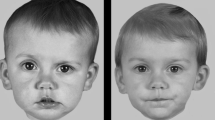Abstract
Ocular disease is one of the causes of abnormal head positioning. Conventionally, the behavioral characteristics of ocular torticollis patients are different from those of non-ocular torticollis patients, though research addressing the significance of this difference is yet limited. This prospective, cross-sectional study aims to develop a questionnaire based on the clinical features in children with abnormal head posture being ocularly assessed. Children aged ≥ 6 months who visited our rehabilitation medicine clinic with a chief complaint of abnormal head posture were included. Patients with apparent orthopedic and neurological diseases were excluded. A 10-item questionnaire was developed to analyze the behavioral characteristics of patients. The patients were divided into ocular and non-ocular torticollis groups according to ophthalmologic examination results. Thirty-four and 13 patients were assigned to the non-ocular torticollis and ocular torticollis groups, respectively. Five questions were finally selected and the questionnaire was scored as the sum of the scores for the each questions (yes = 1 point, no = 0 point). The median (interquartile range) score of the ocular torticollis group (3.0 (3.0–4.0)) was significantly higher than that of the non-ocular torticollis group (2.0 (1.0–3.0); p = 0.000).
Conclusion: Our parent-reported torticollis assessment questionnaire may be useful for screening ocular torticollis.
What is known: • Ocular disease is one of the various causes of abnormal head positioning. • The behavioral characteristics of patients with ocular torticollis are different from those of patients with non-ocular torticollis; research on this matter is limited. | |
What is new: • We delveloped a questionnaire to differentiate ocular and postural torticollis and the score of the questionnaire was different between patients with or without ocular disease. • The questionnaire based on behavioral characteristics may help screening and determining the need of ophthalmic evaluation in patients with torticollis. |



Similar content being viewed by others
Abbreviations
- ROC:
-
Receiver operation characteristic
- AUC:
-
Area under curve
- SE:
-
Standard error
- CI:
-
Confidence interval
References
Cooperman DR (1997) The differential diagnosis of torticollis in children. Phys Occup Ther Pediatr 17:1–11. https://doi.org/10.1080/J006v17n02_01
Ballock RT, Song KM (1996) The prevalence of nonmuscular causes of torticollis in children. J Pediatr Orthop 16:500–504. https://doi.org/10.1097/00004694-199607000-00016
Nucci P, Curiel B (2009) Abnormal head posture due to ocular problems: a review. Curr Pediatr Rev 5:105–111. https://doi.org/10.2174/157339609788185749
Kushner BJ (1979) Ocular causes of abnormal head postures. Ophthalmology 86:2115–2125. https://doi.org/10.1016/s0161-6420(79)35301-5
Williams C, O’Flynn E, Clarke NM, Morris R (1996) Torticollis secondary to ocular pathology. J Bone Joint Surg Br 78:620–624
Nucci P, Curiel B, Lembo A, Serafino M (2015) Anomalous head posture related to visual problems. Int Ophthalmol 35:241–248. https://doi.org/10.1007/s10792-014-9943-7
Nucci P, Kushner BJ, Serafino M, Orzalesi N (2005) A multi-disciplinary study of the ocular, orthopedic, and neurologic causes of abnormal head postures in children. Am J Ophthalmol 140:65–68. https://doi.org/10.1016/j.ajo.2005.01.037
Madigan WP, Zein WM (2008) Recent developments in the field of superior oblique palsies. Curr Opin Ophthalmol 19:379–383. https://doi.org/10.1097/icu.0b013e328309f191
Ray D, Gupta A, Sachdeva V, Kekunnaya R (2014) Superior oblique palsy: epidemiology and clinical spectrum from a tertiary eye care center in South India. Asia Pac J Ophthalmol (Phila) 3:158–163. https://doi.org/10.1097/apo.0b013e31829fbab4
Kim JK, Yim SY (2011) Clinical characteristics of abnormal postures of the head and neck caused by unilateral superior oblique palsy. J Korean Acad Rehab Med 35:272–278
Ivanir Y, Trobe JD (2017) Comparing hypertropia in upgaze and downgaze distinguishes congenital from acquired fourth nerve palsies. J Neuroophthalmol 37:365–368. https://doi.org/10.1097/wno.0000000000000460
Friendly D (1989) Visual acuity assessment of the preverbal patientThe eye in infancy. Year Book Medical Publishers Chicago, pp 48
Bielschowsky A (1938) Disturbances of the vertical motor muscles of the eyes. Arch Ophthalmol 20:175–200. https://doi.org/10.1001/archopht.1938.00850200013001
Mims J 3rd (2003) The Triple Forced Duction Test(s) for diagnosis and treatment of superior oblique palsy--with an updated flow chart for unilateral superior oblique palsy. Binocul Vis Strabismus Q 18:15–24
Greenberg MF, Pollard ZF (2000) Ocular plagiocephaly: ocular torticollis with skull and facial asymmetry. Ophthalmology 107:173–178. discussion 178-9. https://doi.org/10.1016/s0161-6420(99)00004-4
Plager DA (1990) Traction testing in superior oblique palsy. J Pediatr Ophthalmol Strabismus 27:136–140
Paysee EA, Coats DK, Plager DA (1995) Facial asymmetry and tendon laxity in superior oblique palsy. J Pediatr Ophthalmol Strabismus 32:158–161
Singh A, Parihar J, Maggon R, Kumar S, Mishra S, Badhani A (2017) Chronic acquired ocular torticollis: a diagnostic dilemma. Med J Armed Forces India 73:91–93. https://doi.org/10.1016/j.mjafi.2015.08.002
Rosenbaum AL, Santiago AP, Hunter D (1999) Clinical strabismus management: principles and surgical techniques. Saunders, Philadelphia
Shin I-H, Choi M-Y (2003) Clinical assessment of anomalous head postures in children. J Kor Ophth Soc 44:2077–2084
Tumturk A, Ozcora GK, Bayram AK, Kabaklioglu M, Doganay S, Canpolat M, Gumus H, Kumandas S, Unal E, Kurtsoy A (2015) Torticollis in children: an alert symptom not to be turned away. Childs Nerv Syst 31:1461–1470. https://doi.org/10.1007/s00381-015-2764-9
Acknowledgments
The authors gratefully acknowledge Jinmi Kim (Department of Biostatistics, Biomedical Research Institute, Pusan National University hospital) for providing helpful comment of statistical analysis.
Author information
Authors and Affiliations
Contributions
Research design: JAY, HYC, YBS, and HJ; data acquisition and research execution: JAY, HYC, YBS, and HJ; data analysis and interpretation: JAY and HS; manuscript preparation: JAY and HS.
Corresponding author
Ethics declarations
Conflict of interest
The authors declare that they have no conflict of interest.
Ethical approval
This research protocol involving human participants and the protocol was approved by the Institutional Review Board (IRB)/Ethics Committee in Pusan National University hospital (approval number: 1802-024-074). This study complied with the principles of the Declaration of Helsinki.
Informed consent
Informed consent was obtained from all individual participants included in the study.
Additional information
Communicated by Gregorio Paolo Milani
Publisher’s note
Springer Nature remains neutral with regard to jurisdictional claims in published maps and institutional affiliations.
Rights and permissions
About this article
Cite this article
Yoon, J.A., Choi, H., Shin, Y.B. et al. Development of a questionnaire to identify ocular torticollis. Eur J Pediatr 180, 561–567 (2021). https://doi.org/10.1007/s00431-020-03813-2
Received:
Revised:
Accepted:
Published:
Issue Date:
DOI: https://doi.org/10.1007/s00431-020-03813-2




